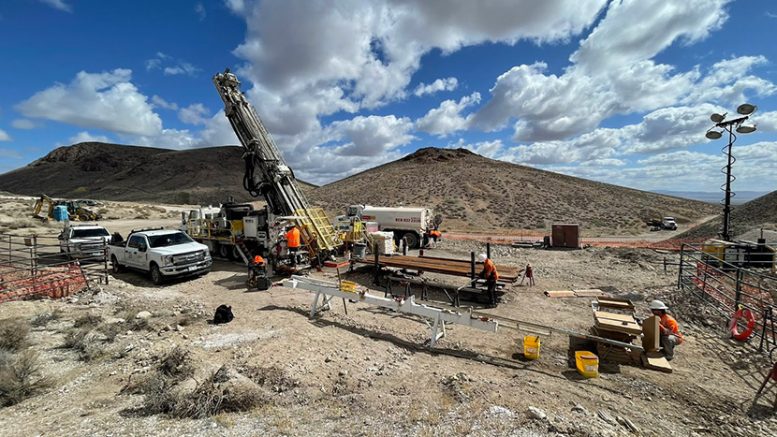In the spring of 2020, when many mines around the world were grinding operations to a halt, a group of seasoned exploration geologists saw an opportunity to acquire assets in the minerals-rich Southwestern United States, and so formed a new company, Summa Silver (TSXV: SSVR).
Led by CEO Galen McNamara, co-winner of the 2018 PDAC Bill Dennis “Prospector of the Year” Award, 2016 Mines and Money Exploration Award and former senior project manager – Exploration & Development at NexGen Energy, Summa Silver acquired 100% ownership of the Hughes property in Nevada in March 2020 in the Tonopah District. Discovered in 1900, the district became known as the Queen of the Silver Camps.
The Nevada package is named after the famed Howard Hughes, who was one of the former owners.
The Tonopah mining district is an intermediate sulfidation epithermal vein system. Productive veins in the district are hosted in volcanic rocks which range in composition from andesite to rhyolite. High-grade mineralization in the veins consists of argentite, polybasite, electrum, sphalerite, galena and chalcopyrite, based on historical data.
The Belmont Mine was one of the top-producing mines of the Tonopah district and was one of America’s great silver producers of the time. Summa Silver compiled historic drill data and began geological modelling, going for extensions of veins, parallel structures and discovered unexplored regions surrounding Belmont – 3,969 acres along a 5.5 km strike length with highway and powerlines on the property.
The company began drilling in June 2020 and has since drilled 50 holes on four targets and hit high grade silver on all of them on a strike length of three and a half kilometres.
“We’re looking for an extension of the entire district … we’re looking for another 200 million ounces,” says McNamara.
Summa Silver has completed 10,000 metres in the 2021 drill program. As the remaining assay results become available, emphasis will shift to refining targets on unexplored areas of this prospective property and finalizing a new drill program for both step-out holes around recently drilled high-grade intersections and holes targeting new discovery.
Drilling is in progress at the Consolidated Extension target where the company anticipates that a minimum of 15,000 m of drilling is necessary. This first target represents only 1.5% of the total vein and structure strike length present on the property.
Drill highlights from Belmont mine include 4,408 grams silver equivalent per tonne over 2.8 metres, 3,760 grams silver-equivalent per tonne over 2.5 metres and 1,699 grams silver-equivalent per tonne over 4.3 metres.
“When these mines shut down, in the late 1920s, they were shuttered and almost no one has done any exploration since – their methods of exploration were so much less efficient. So much of the exploration they did was underground – driving drifts along structures looking for ore shoots,” McNamara says.
Mogollon: “One of the great remaining vein fields still left in the US“
Summa also acquired the Mogollon property in New Mexico. Discovered in the 1880’s by a Sergeant in the U.S. Cavalry who kept the discovery secret until his service ended, McNamara says the Mogollon district presents a rare discovery opportunity and has the potential to be one of the great remaining vein fields still left in the United States.
At least 16.4 million oz. of silver and 339,000 oz. of gold of historic production at grades of 298 grams silver and 6.16 grams gold or 821 grams silver equivalent were reported between the 1880s and 1942.
Summa’s surface sampling comprised 326 channel and grab samples collected from the extensive number of surface prospect pits and trenches present on the property, most of which were previously un-sampled. Ongoing investigation of the historic mines on the property has revealed good access to underground workings in several areas. Systematic sampling will begin in the Last Chance Mine where sulfide-mineralized quartz veins were recently observed.
A property wide soil survey is in progress and will focus on the identification of blind exploration targets which may not have been recognized by past operators.
A 29-sq.-km LiDAR survey was flown to provide topographic control and to identify areas of surface disturbance peripheral and along strike from historic workings. Four hundred line-kilometres of drone-based, high-resolution magnetic data, were collected to refine the property-scale structural model.
Summa is targeting 43-101 resource compliance on both high-grade silver projects by the fourth quarter of 2022.
“With the drilling technology we have today – we’re at the phase where the opportunity is going into these old mining districts with a modern arsenal of weapons,” McNamara says.
“There’s a lot of juice left to squeeze – a lot of low-hanging fruit. At this time we are just trying to figure out how many ounces we have on our hands – because the more we drill the more mineralization we hit.”
The preceding Joint-Venture Article is PROMOTED CONTENT sponsored by Summa Silver and produced in cooperation with The Northern Miner. Visit Summa Silver for more information.


You go, Galen ! Your Tx gals, P,S & G